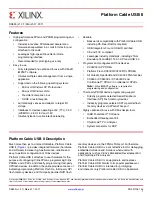
Platform Cable USB II
DS593 (v1.2.1) March 17, 2011
5
approximately 40 seconds over a USB 2.0 port and 60 seconds over a USB 1.1 port. Reprogramming times vary depending
on the Xilinx design tool version, the type of USB port and the performance of the host system.
During a PROM update, the cable's status LED illuminates red (
), and a progress bar indicates
communication activity. PROM updates should never be interrupted. When an update is complete, the status LED returns to
either amber or green, and the cable is ready for normal operation.
Hot Plug and Play
Platform Cable USB II can be attached and removed from the host computer without the need to power-down or reboot.
There is a momentary delay after connecting the cable to an available port before the status LED illuminates — this process
is called enumeration.
Connecting to the Cable in iMPACT
This section describes some of the ways to connect to Platform Cable USB II using the Xilinx iMPACT graphical user
interface (GUI). For cable communication using other Xilinx design tools or methods, please refer to the appropriate software
user guide.
Select a Flow
From the iMPACT GUI, select a flow on the “Modes” tab (
). Double-click on the desired flow.
Note:
For a description of the different flows, please refer to
iMPACT
→
Help
.
Establishing a Connection
Once a flow is selected, there are a number of ways to establish a connection with the cable. Two common options are
described here:
Option 1: Cable Auto Connect
To auto connect the cable, select
Output
→
Cable Auto Connect
).
Note:
During the auto-connect sequence, iMPACT selects Parallel Cable IV (PC4) as the active cable if both PC4 and Platform Cable
USB II are connected to the same host system. If two or more USB cables are connected to the same host, the active cable is the first USB
cable physically connected to the host system. See
Multiple USB Cable Management, page 7
, for information on controlling more than one
USB cable from a single application.
X-Ref Target - Figure 3
Figure 3:
iMPACT (9.2i) Modes Tab
DS593_03_021408




















